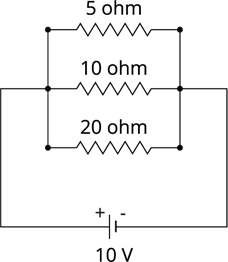PDF chapter test TRY NOW
In the circuit diagram given below, three resistors R_1, R_2 and R_3 of 5\ Ω, 10\ Ω and 20\ Ω, respectively are connected as shown.

Circuit diagram
Calculate,
(a) Current through each resistor
(b) Total current in the circuit
(c) Total resistance in the circuit
(b) Total current in the circuit
(c) Total resistance in the circuit
(a) Since the resistors are connected in parallel, the potential difference across each resistor is same (i.e. V = 10V). Therefore, the current through each resistor is calculated by the formula,
Current through R_1 = A
Current through R_2 = A
Current through R_3 = A
(b) Total current in the circuit,
On substituting the known current values, we get
= A
(c) Total resistance in the circuit,
On substituting the known values, we get
=
